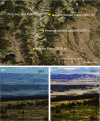How shrub encroachment under climate change could threaten pollination services for alpine wildflowers: A case study using the alpine skypilot, Polemonium viscosum
- PMID: 28904775
- PMCID: PMC5587488
- DOI: 10.1002/ece3.3272
How shrub encroachment under climate change could threaten pollination services for alpine wildflowers: A case study using the alpine skypilot, Polemonium viscosum
Abstract
Under climate change, shrubs encroaching into high altitude plant communities disrupt ecosystem processes. Yet effects of encroachment on pollination mutualisms are poorly understood. Here, we probe potential fitness impacts of interference from encroaching Salix (willows) on pollination quality of the alpine skypilot, Polemonium viscosum. Overlap in flowering time of Salix and Polemonium is a precondition for interference and was surveyed in four extant and 25 historic contact zones. Pollinator sharing was ascertained from observations of willow pollen on bumble bees visiting Polemonium flowers and on Polemonium pistils. We probed fitness effects of pollinator sharing by measuring the correlation between Salix pollen contamination and seed set in naturally pollinated Polemonium. To ascertain whether Salix interference occurred during or after pollination, we compared seed set under natural pollination, conspecific pollen addition, and Salix pollen addition. In current and past contact zones Polemonium and Salix overlapped in flowering time. After accounting for variance in flowering date due to latitude, Salix and Polemonium showed similar advances in flowering under warmer summers. This trend supports the idea that sensitivity to temperature promotes reproductive synchrony in both species. Salix pollen is carried by bumble bees when visiting Polemonium flowers and accounts for up to 25% of the grains on Polemonium pistils. Salix contamination correlates with reduced seed set in nature and when applied experimentally. Postpollination processes likely mediate these deleterious effects as seed set in nature was not limited by pollen delivery.
Synthesis: As willows move higher with climate change, we predict that they will drive postpollination interference, reducing the fitness benefits of pollinator visitation for Polemonium and selecting for traits that reduce pollinator sharing.
Keywords: Polemonium viscosum; Salix; climate change; heterospecific pollen transfer; plant–climate interactions; reproductive ecology; selection on floral traits; shrub encroachment.
Figures






Similar articles
-
Density-dependent effects of ants on selection for bumble bee pollination in Polemonium viscosum.Ecology. 2007 May;88(5):1202-9. doi: 10.1890/06-1455. Ecology. 2007. PMID: 17536406
-
Interspecific pollen transfer as a mechanism of competition: Consequences of foreign pollen contamination for seed set in the alpine wildflower, Polemonium viscosum.Oecologia. 1989 Oct;81(1):120-123. doi: 10.1007/BF00377020. Oecologia. 1989. PMID: 28312167
-
POLLEN DISPERSAL DYNAMICS IN AN ALPINE WILDFLOWER, POLEMONIUM VISCOSUM.Evolution. 1992 Aug;46(4):1043-1051. doi: 10.1111/j.1558-5646.1992.tb00618.x. Evolution. 1992. PMID: 28564397
-
Bumble bee behavior and selection on flower size in the sky pilot, Polemonium viscosum.Oecologia. 1987 Nov;74(1):20-23. doi: 10.1007/BF00377340. Oecologia. 1987. PMID: 28310409
-
Multifunctional Material Building Blocks from Plant Pollen.Annu Rev Chem Biomol Eng. 2024 Apr 25. doi: 10.1146/annurev-chembioeng-101121-085959. Online ahead of print. Annu Rev Chem Biomol Eng. 2024. PMID: 38663029 Review.
Cited by
-
Manual Sampling and Video Observations: An Integrated Approach to Studying Flower-Visiting Arthropods in High-Mountain Environments.Insects. 2020 Dec 11;11(12):881. doi: 10.3390/insects11120881. Insects. 2020. PMID: 33322607 Free PMC article.
References
-
- Ågren, J. (1988). Sexual differences in biomass and nutrient allocation in the dioecious Rubus chamaemorus . Ecology, 69, 962–973.
-
- Arceo‐Gomez, G. , & Ashman, T. L. (2016). Invasion status and phylogenetic relatedness predict cost of heterospecific pollen receipt: Implications for native biodiversity decline. Journal of Ecology, 104, 1003–1008.
-
- Ashman, T. L. , & Arceo‐Gómez, G. (2013). Toward a predictive understanding of the fitness costs of heterospecific pollen receipt and its importance in co‐flowering communities. American Journal of Botany, 100, 1061–1070. - PubMed
-
- Bartoń, K. , and R Development Core Team .(2015). MuMIn: Multi‐model inference. R Package.
-
- Becklin, K. M. , Pallo, M. L. , & Galen, C. (2012). Willows indirectly reduce arbuscular mycorrhizal fungal colonization in understory communities. Journal of Ecology, 100, 343–351.
LinkOut - more resources
Full Text Sources
Other Literature Sources
Research Materials
Miscellaneous

